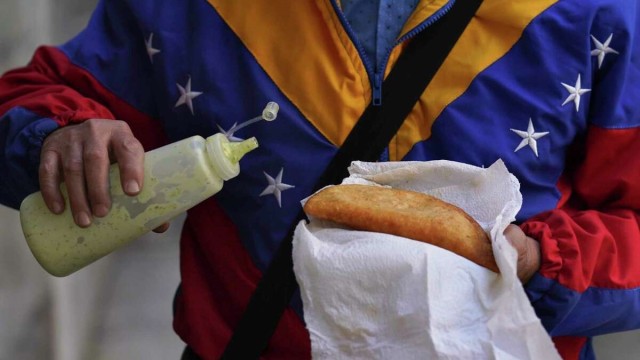
The eyes of Fabiana Márquez brightened after she took the first bite of a savory, crescent-like bread stuffed with ham and cheese. Memories flooded her mind. The Venezuelan immigrant hadn’t eaten a “cachito” in almost five years until she stumbled across a vendor outside her country’s embassy in México.
By SFGate –
May 2, 2022
Marquez left her South American homeland in 2017 amid a social, political and humanitarian crisis that has now driven more than 6 million to migrate across the continent and beyond. She has worked as a nanny, housekeeper, waitress and at other jobs to make ends meet, mostly in outlying parts of México. In the process, she severed deep roots to her country, including the food close to her heart.
“It gave me great pleasure because I hadn’t eaten Venezuelan food in many years,” Márquez said standing next the vendor, who had plastic containers stuffed with a variety of Venezuelan food along a street in a tony México City neighborhood. “Since I arrived in México, I had eaten just a few arepas, but I had completely disconnected from what Venezuelan food is.”
But if she feels cut off from the cuisine of her homeland, many Mexicans have come to discover it. The Venezuelan diaspora has brought shops selling arepas – stuffed corn cakes common to that country and neighboring Colombia. They also are increasingly filling their fellow immigrants’ yearning for cachitos, empanadas and pastelitos while earning much-needed money.
Many of the shops are concentrated in the trendy Roma neighborhood, but they’ve also emerged in middle- and working-class districts, as well as cities such as Cancun and Acapulco, Puebla and Aguascalientes, Metepec and Culiacan.
Nelson Banda used to own a clothing factory about 80 miles west of Caracas, Venezuela’s capital, and sold school uniforms across the country. But as soaring production costs due to inflation ate up any profits, he closed shop a year and a half ago, sold off equipment and joined relatives in México City.
Banda sells about 80 empanadas and 40 cachitos a day outside the Venezuelan Embassy. Clad in a windbreaker with the colors of his country’s flag, he also sells the non-alcoholic malt drink that is a staple at the Venezuelan breakfast table.
Most of Banda’s customers are people like Márquez who must visit the embassy, but he also has regulars.
“They feel the warmth of Venezuela when they see these (foods),” Banda said. “Here, there is a large Venezuelan community, and well, among the community, everyone tries to survive; everyone sets up their own business in their own way and sells what they can.”
International migration agencies estimate Latin American and Caribbean countries have received over 80% of the Venezuelans who left their country in recent years. Colombia and Perú have received the most, but until recently, México also was a popular option because it demanded no visa from Venezuelans and is close to the U.S., which many hoped to reach one day.
México, however, began requiring visas of Venezuelans in January after imposing similar restrictions on Brazilians and Ecuadorians in response to large numbers of migrants headed to the U.S. border.
…
Read More: SFGate – Venezuelan immigrants bring flavors from home to new lands
…

